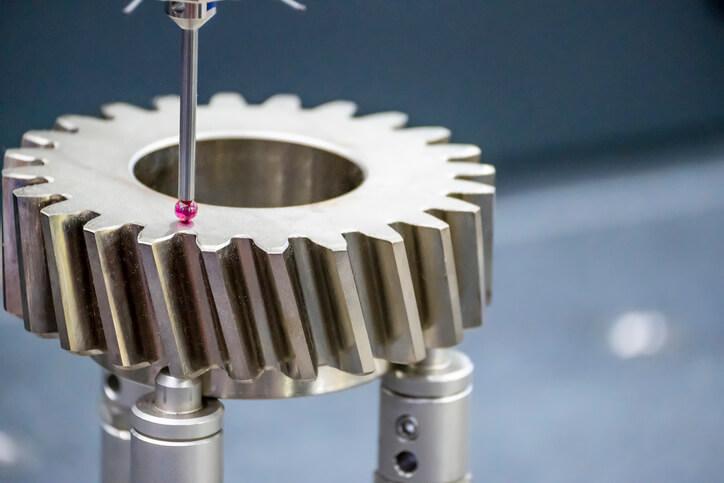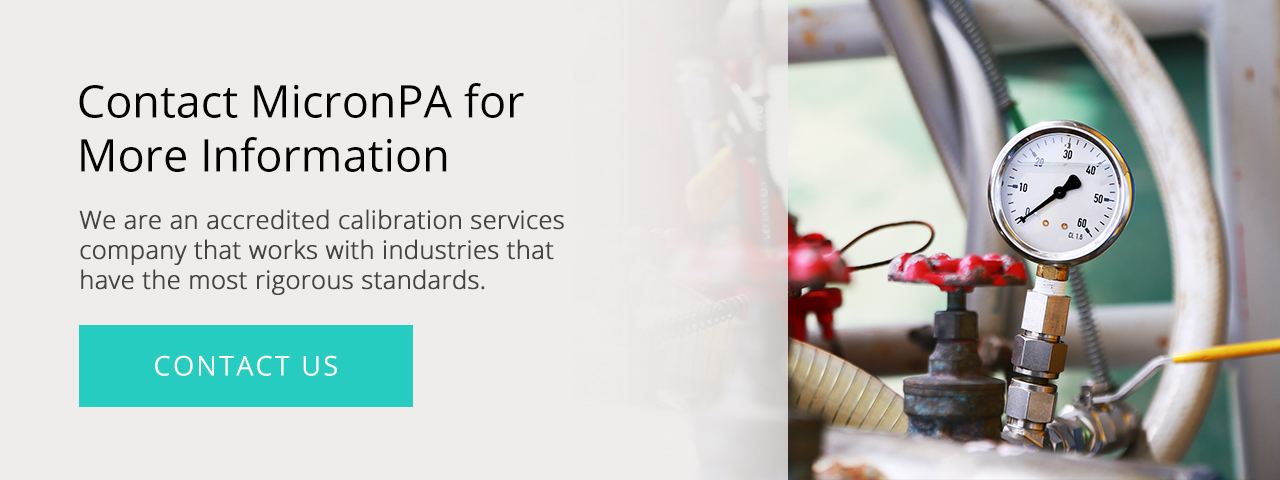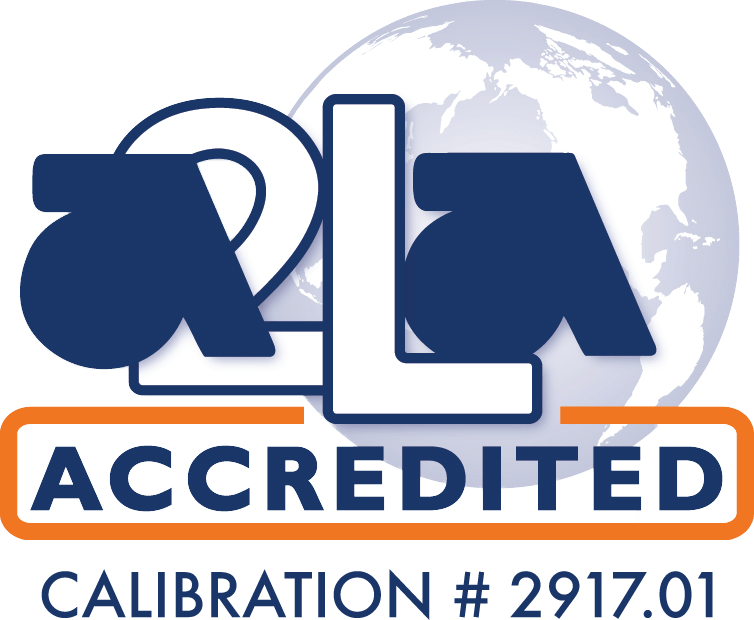
Inspection by attributes provides an accurate, effective method of sampling products for quality assurance. However, this process is only as good as the information and equipment used to make the measurements. Correctly calibrated measuring equipment will make the inspection by attributes process as accurate and efficient as possible.
Table of content
- How Are “Inspections by Attributes” and Calibration Connected?
- Inspection by Attributes vs. Variable Inspection
- The Importance of Attribute Inspection and Its Benefits
- The Applications of Inspection by Attributes Sampling
- Contact MicronPA for More Information
How Are “Inspections by Attributes” and Calibration Connected?
Proper calibration is integral to the inspection by attributes process. Without it, the process will not be as accurate as necessary. However, with correctly calibrated equipment, inspection by attributes serves as a highly efficient means of examining samples for issues. It speeds the inspection process and can help cut costs without sacrificing quality. Therefore, any facility that conducts sample inspections by attributes must first ensure that they have correctly calibrated measuring equipment.
What Is Inspection by Attributes?
Inspection by attributes either determines whether an attribute is conforming or nonconforming to a specific requirement. This inspection process is binary, giving a yes or no to the conforming of an attribute to a given standard. Some methods calculate the number of nonconforming attributes in a process or device as part of the inspection. Some items may be rejected based on nonconforming in a single attribute or based on several attributes.
When conducting inspections by attributes, defects and nonconformities are two closely related but separate concepts in the process. Nonconformity means the characteristic inspected does not meet specified requirements whereas a defect indicates a problem with a characteristic that can affect typical usage. Defects should result in rejection of a component because they could result in unsafe or unstable devices. Whether a nonconformity causes immediate rejection depends on the criteria used for inspection and rejection.
What Is the Process for Sampling With Inspection by Attributes?
The inspection by attributes process starts with selecting a sampling plan. Types of plans include c=0 or zero acceptance, single-sample plan, double-sample plan and multi-sample plans.
The first of these plans, c=0 or zero acceptance, is a highly rigorous form of a single-sample plan. In this plan, one product with a defect results in rejecting the entire lot. For some industries, such as food and pharmaceuticals, this option is acceptable because consumer safety and health are on the line. The zero acceptance plan has the smallest sampling size but errors in measuring pose the greatest risk for loss.
In a single-sample plan, one sample lot undergoes testing. Whether to reject a lot depends on how many in the sample exceed the required number for nonconformity in the reference tables that indicate acceptable quality levels (AQLs). For instance, if a table requires acceptance on three and rejection on four, a sample with four nonconforming parts would require complete rejection. If it only had three or fewer, the lot may be accepted.
Double-sampling plans may classify the lot as acceptable, rejectable or resamplable. If the lot undergoes resampling, data from the second sampling combines with the information gathered from the first sampling to either accept or reject the lot.
Multi-sample plans can indicate acceptable, unacceptable or marginally acceptable lots based on sampling lots three or more times. Due to the complexity of this plan, it is used infrequently.
When conducting inspection by attributes, rejected lots need to undergo careful scrutiny to find the cause of the rejection. Measures to improve product quality may make future lots acceptable, but resampling the same lot will not likely produce different results. Therefore, use inspection by attributes to test whether to accept or reject products, materials or components and investigate if lots require rejection during the testing process.
What Is the Calibration Process?
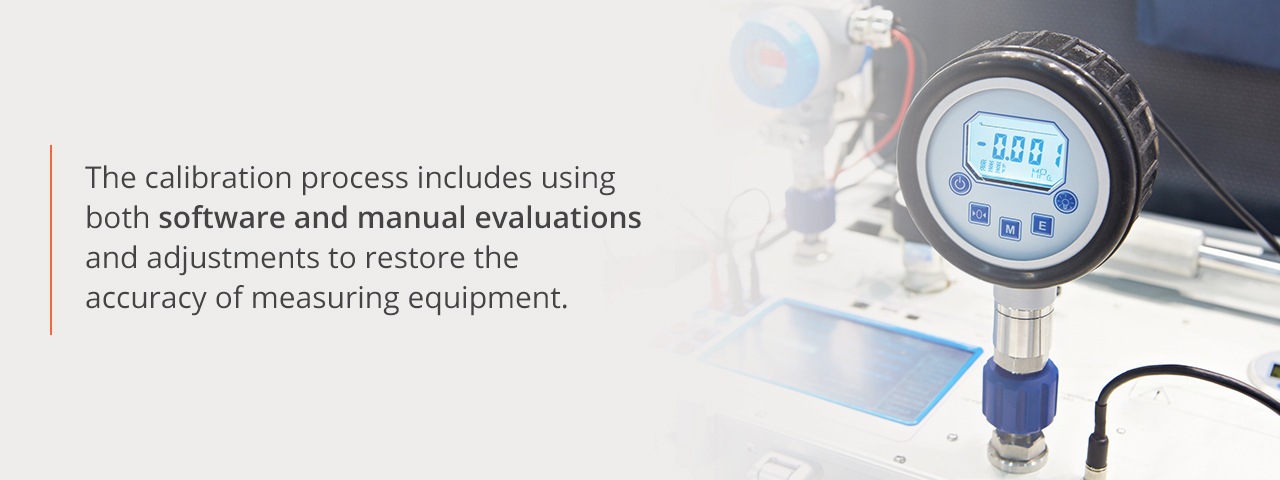
The calibration process requires several steps to ensure that the equipment is accurately set to established standards. Specifics of calibration depend on the device undergoing the process. However, all calibrations should follow established standards.
An accredited calibration firm, such as MicronPA, has accreditation from the American Association for Laboratory Accreditation (A2LA) for American National Standards Institute and the National Conference of Standards Laboratories (ANSI/NCSL) Z540.3-2006 and Z540-1-1994. Additionally, we have accreditation under International Organization for Standardization and the International Electrotechnical Commission (ISO/IEC) 17025:2017.
Calibration services for specific devices include the following:
- Mechanical calibration: Including pressure gage, torque wrench and torque transducers
- Gage calibration: Services include repair, testing and calibration of gages
- Electronic calibration: Calibrating multimeters, microwave devices, RF devices and National Instruments equipment
- Dimensional calibration: Verifies and adjusts gages such as Micrometers, Calipers, etc.
The calibration process includes using both software and manual evaluations and adjustments to restore the accuracy of measuring equipment. Equipment that requires repairs will also undergo testing and calibration to ensure that its accuracy is restored through the repair process.
Additionally, calibration can occur in a laboratory or on-site. Lab calibration services require products to ship to one of our labs for repairs or calibration. All products calibrated receive certification ensuring the accuracy of the resulting equipment to specified standards.
On-site calibrations are ideal for equipment too big to ship or when time is essential for the process. Technicians use the same exacting requirements for on-site work as they use for lab calibrations. Therefore, the equipment tested and adjusted on-site follows the same procedures and meets the same standards as laboratory-calibrated equipment.
Inspection by Attributes vs. Variable Inspection
Inspection by attributes and using variables are two methods of testing batches. While the two use different metrics, they also produce results that require separate interpretations. Comparing the two to choose a sampling method may require examining resources available for testing and whether a binary result or a more comprehensive answer will suffice.
Attributes vs. Variables
Inspection by attributes gives a binary result of conforming or nonconforming. Whether to accept or reject a lot depends on how many pieces in a batch are non-conforming. However, inspection by attributes does not indicate how far from a given parameter the nonconforming pieces were.
Variables inspection looks at several different variables for pieces to determine how close they are to the specified limit or nominal value. However, the process requires taking extensive measurements that must be highly accurate. Plus, the process assumes that the population testers pull the sample batch from is normal. The higher number of measurements required and the multiple variables for each piece make inspection by variables highly complex and more expensive than inspection by attributes. Variables inspection works well when fine-tuning the production process to ensure quality products. Testers can determine the degree outside the norm that values are and thus facilitate the changes required to bring future samples closer to the required values.
Attributes inspection works best when testing the degree of conformity does not affect the useability of an item. For instance, the degree to which the dimensions of produced shafts deviate from the required amount does not matter once they are made. Whether they meet the dimension standard is more important. Producers must discard the entire batch because even a slight amount outside the norm will not allow the shaft to serve its purpose. Another use for inspection by attributes is when measuring the quality is too difficult. For instance, when evaluating that products have a finishing coating applied rather than testing the degree of coating on every sample.
Inspection Results

The inspection process for attributes uses samples to determine whether the batch has too many nonconforming products or not. For inspection by variables, testing samples may occur at many steps in the process and testers may take several measurements of samples. The information goes into a pair of control charts that indicate the average of the samples and the range of the information. The range indicates how close to the average the samples fall. For attribute control charts, there is a single metric that indicates how many pieces conform or don’t conform to the required measurement.
Variable inspection’s complex results and processes that require multiple measurements can make it less cost-effective than inspection by attributes, especially when additional information is not required or used. Both inspections by attributes and by variables are important and have their places in testing. Choosing the incorrect testing procedure could waste time and money without giving better results.
The Importance of Attribute Inspection and Its Benefits
Inspection by attribute offers multiple advantages when inspecting products. The process requires less time for sampling, offers high efficiency and ensures a high level of accuracy. Combined, these benefits make inspection by attribute an economical option, especially when sampling more products is prohibitive.
Less Time
The sampling process requires less time compared to testing 100% of a lot. By taking less time, the inspection process costs less money. Plus, products can get out faster because a lot can undergo complete acceptance or rejection based on the inspection by attributes testing.
Compared to inspecting variables, inspection by attribute takes less time because a component or product may have multiple variables that would require testing instead of testing conformity or nonconformity of the entire product.
High Efficiency and Accuracy
Testers can experience fatigue when having to test 100% of a batch. Tired or worn-out inspectors can make mistakes, reducing their accuracy. Plus, fatigued testers can take longer to perform the test.
Sampling smaller batches also protects the full lot. Even if the inspection process doesn’t destroy or damage the products, it can still produce unseen changes in the items. When taking smaller samples, fewer goods must undergo the process, allowing for more products to remain untouched.
When sampling a smaller batch out of a lot, inspectors take less time and perform more accurately. Therefore, they increase their efficiency and can conduct more tests of other batches of products or goods.
The Applications of Inspection by Attributes Sampling
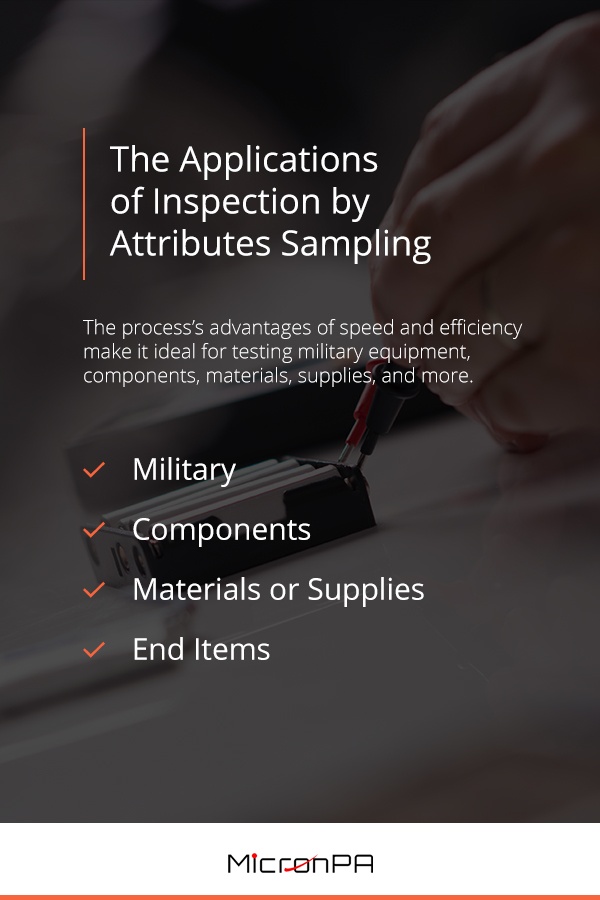
Inspection by attributes sampling works well in many applications. The main factor in deciding when to use inspection by attributes is whether a yes or no answer is all that the testing process needs to return. For deciding if products or materials are up to specified standards, inspection by attributes is a fast, simple option. The process’s advantages of speed and efficiency make it ideal for testing military equipment, components, materials, supplies, and more.
Military
Sampling through inspection of attributes originated with the Military Standard 105. These standards were required for testing munitions and other items that could not undergo 100% testing due to the product destruction that occurred during testing. Initially, the standards started with standards tables in 1942 and 1943 with more precise standards under the 105 designation starting in 1950.
Over time, the military and civilian standards merged. Today, ISO and ANSI standards have their origins in these military guidelines, and since 1995, the military opted to use these standards rather than separate military standards for sampling.
Components
Components of a device can undergo attributes sampling to ensure the quality of the completed parts. For instance, testing the parts that make up a piece of equipment before putting them together ensures quality from a fundamental level. Plus, doing testing at the component level allows companies to stop production and make changes if a lot requires rejection. Companies can avoid problems with products that originate from component defects or nonconformity by sampling components and doing inspections by attributes of them.
Materials or Supplies
Testing the raw materials or supplies used to create components through sampling may be beneficial when using consumable materials or supplies that will not last through the sampling. For instance, the pharmaceutical industry frequently uses inspection by attributes of ingredients or raw materials as recommended by the World Health Organization (WHO). For Food and Drug Administration (FDA) regulated products, manufacturers should adopt a zero-acceptance sampling plan (c=0). Zero acceptance sampling is also appropriate for food product ingredients.
End Items
End products may require sampling using inspection by attribution to ensure quality as products come off the line. By using this inspection process, all products do not have to undergo testing, making it faster to get the products out for delivery after production. For example, taking samples for inspection by attribution can occur as production proceeds by pulling products off the line as they are made over several days. Doing this saves time and prevents the need to stockpile products first to conduct testing.
Plus, sampling finished products makes the testing process fast and accurate. However, manufacturers should optimize the production process to ensure the fewest defects or nonconforming tested products. Batches that require rejection cause wasted time and necessitate additional testing of the other goods produced or starting over from scratch. Instead of taking this costly route, companies should do everything possible to ensure their end products will meet the basic requirements of an inspection by attributes.
Contact MicronPA for More Information
Since well-calibrated instruments are the backbone to conducting inspection by attributes, get your equipment professionally calibrated with MicronPA. We are an accredited calibration services company that works with industries that have the most rigorous standards – defense, medical, pharmaceuticals, aerospace and automotive. Contact us for more information about our calibration services or to find out how well-calibrated equipment makes a difference in quality control.


